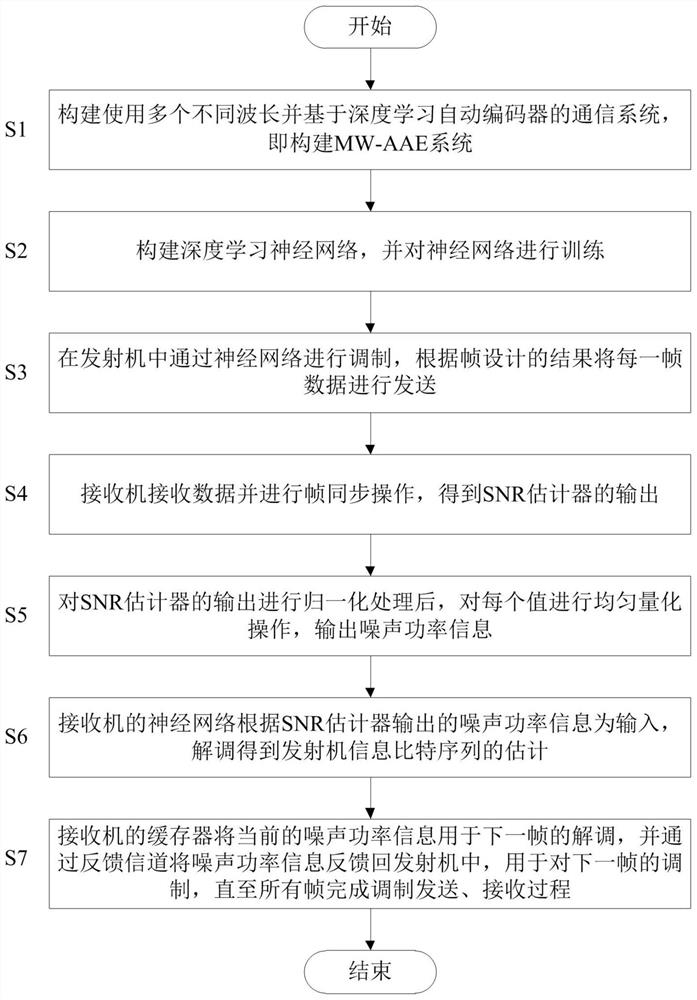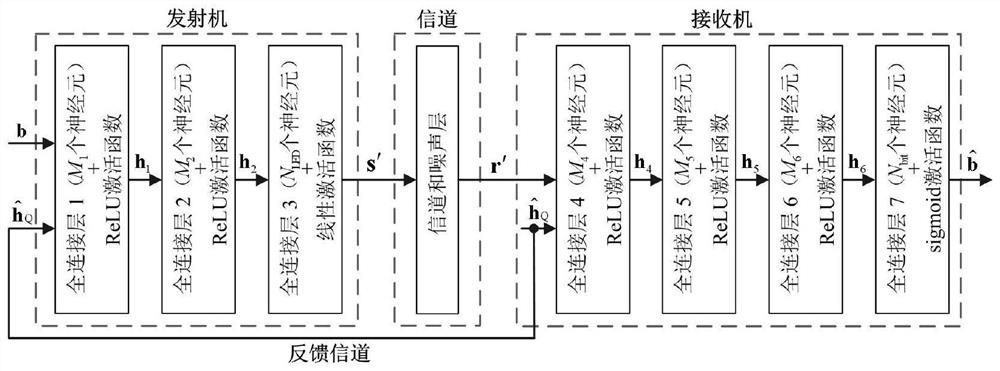Multi-wavelength LED underwater visible light communication modulation method based on deep learning
A technology of visible light communication and deep learning, which is applied in the field of multi-wavelength LED underwater visible light communication modulation based on deep learning, and can solve the problems that cannot meet the requirements of non-negative real signals at the same time
- Summary
- Abstract
- Description
- Claims
- Application Information
AI Technical Summary
Problems solved by technology
Method used
Image
Examples
Embodiment 1
[0074] Such as figure 1 As shown, the present invention provides a multi-wavelength LED underwater visible light communication modulation method based on deep learning, comprising the following steps:
[0075] S1: Construct a communication system using multiple different wavelengths and based on deep learning autoencoders, that is, constructing a MW-AAE system;
[0076] S2: Construct a deep learning neural network and train the neural network;
[0077] S3: Modulate through the neural network in the transmitter, and send each frame of data according to the result of frame design;
[0078] S4: The receiver receives the data and performs frame synchronization operation to obtain the output of the SNR estimator;
[0079] S5: After normalizing the output of the SNR estimator, perform a uniform quantization operation on each value, and output noise power information;
[0080] S6: The neural network of the receiver takes the noise power information output by the SNR estimator as i...
Embodiment 2
[0084] More specifically, on the basis of Embodiment 1, the MW-AAE scheme designed in the present invention is applied to short-distance underwater VLC diffuse link scenarios in open sea water bodies and offshore water bodies. The underwater VLC simulation results under different turbulence intensities, different distances and different water bodies show that the MW-AAE scheme designed by the present invention has better performance under the same spectral efficiency than existing schemes in most underwater environments. BER performance.
[0085] The system block diagram of the MW-AAE scheme designed by the present invention is as figure 2 shown. Note that for ease of understanding, figure 2 It is only a specific embodiment of the solution designed by the present invention. In fact, the solution designed by the present invention can also use multiple LEDs of different wavelengths other than red, green and blue for communication.
[0086] A. Underwater multi-wavelength VLC...
Embodiment 3
[0147] More specifically, as a specific embodiment of the scheme designed in the present invention, N can be taken as LED = 3, λ 1 =625nm,λ 2 =525nm,λ 3 =470nm; 3 LEDs and 3 photodetectors are arranged in a straight line, the straight lines formed by the LEDs and the straight lines formed by the photodetectors are parallel to each other, and the centers of every two adjacent LEDs and every two adjacent photoelectric detectors The distance between the detector centers is equal, denoted as l 0 .
[0148] In the specific implementation process, the frame header Barker code can be used; the frame length can be 4×10 -6 s; set figure 2 The transmitter's buffer and the receiver's buffer in , so that the input of the receiver neural network is used when the symbol to be demodulated is modulated by the transmitter neural network same.
[0149] based on image 3 And the neural network structure shown in formula (11)-(18) is trained. Use the loss function shown in Equation...
PUM
 Login to View More
Login to View More Abstract
Description
Claims
Application Information
 Login to View More
Login to View More - R&D
- Intellectual Property
- Life Sciences
- Materials
- Tech Scout
- Unparalleled Data Quality
- Higher Quality Content
- 60% Fewer Hallucinations
Browse by: Latest US Patents, China's latest patents, Technical Efficacy Thesaurus, Application Domain, Technology Topic, Popular Technical Reports.
© 2025 PatSnap. All rights reserved.Legal|Privacy policy|Modern Slavery Act Transparency Statement|Sitemap|About US| Contact US: help@patsnap.com



